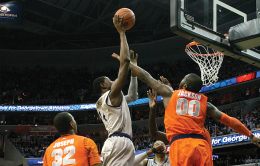

Unfortunately for Georgetown’s student-athletes, much of the talk surrounding them and their teams over the next few years will have nothing to do with their accomplishments. Instead, there will be much attention devoted to the game of musical chairs being played in college athletics, a game that has thrown the future of many conferences into question. But no major conference’s future is in as much danger as that of the Big East.
After the defections of Pittsburgh, Syracuse, Texas Christian and West Virginia, the Big East is left with just five football teams. Schools like Central Florida, the service academies and even Boise State have been suggested as possible replacements in the weeks following news of the departures. The problem for a basketball school like Georgetown — which does not field a team in the Football Bowl Subdivision — and several of its Big East counterparts like Villanova, Marquette and St. John’s, is that the money in collegiate athletics is in football. Georgetown’s decision-making process is significantly different than that of schools with big-time football programs.
“We don’t have the same level of football as the institutions that are making these changes,” Georgetown men’s basketball Head Coach John Thompson III said. “Basketball will be at the forefront of all the decisions we make.”
Perhaps the most obvious impact of the Orange leaving the Big East is the potential disappearance or marginalization of the longtime Syracuse-Georgetown rivalry, which is treasured by fans on both sides.
Complicating matters, it is not clear that all of the five football schools remaining in the Big East — Connecticut, Louisville, Cincinnati, South Florida and Rutgers — want to stay. Not only does this make it harder to attract schools to replace the four that have left, but it incentivizes all of the FBS football schools to start exploring other options, even those who want to remain in the Big East. Because of the Big East’s large number of non-football members, this has created an interesting problem for the conference’s athletic directors: the basketball schools do not want to dilute the quality of play in their sport of choice, but it is obvious that increasing football membership is the only way to keep the conference together, even if it means accepting teams like East Carolina or UCF that have relatively weak basketball programs.
“What’s going on in our conference, in many ways, you knew change was coming,” Thompson III said. “Intercollegiate athletics is going through a transformation, a change, an evolution, and what will happen in 26 months with the Big East is part of that change.”
These changes won’t have any immediate impact on Georgetown’s schedule, but that doesn’t mean Thompson III expects his players and staff to be able to tune out talk of conference realignment. The basketball program’s future might be in flux, but the games still have to be played.
“[The Big East] is the talk of the day, and it is important,” Thompson III said. “You can’t ignore it. You can’t put your head in the sand and block it out, because it is a part of who we are and what we do.”









